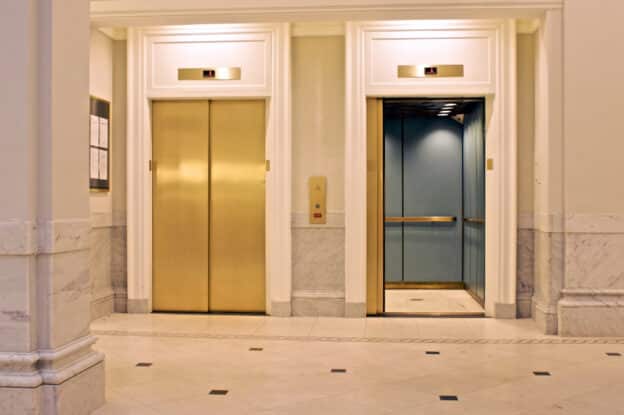Since the early 2000’s, Shabbat elevators have become popular across the Jewish world in the wake of modern, high-rise construction, a norm in many observant communities. The need for a Shabbat elevator is now a necessity especially for the elderly or infirm, and Orthodox families living with young children on upper floors of high buildings. In Israel, Shabbat elevators are generally found in hotels, hospitals and other health institutions, apartment buildings, and even in some synagogues. Read on to learn who decides on the installation and operation of a Shabbat elevator in Israel, who pays the costs, and what happens when there is a dispute.
With the operation of a Shabbat control mode, an elevator can be programmed to stop and open its doors automatically on certain floors, hence allowing users to step in and out without having to press any buttons. Otherwise it would be prohibited to use an elevator on Shabbat because pressing the button to operate the elevator closes a circuit, which violates the prohibition of building on Shabbat, considered a form of labor.
There are several ways the Shabbat elevator can be operated going up and down. For example, either by stopping at every floor on the way up and then coming straight down to the bottom without making any stops, or by rising to the top floor and stopping on pre-selected floors while going down. Generally, Shabbat elevators are set to automatically stop on every floor for 20 to 30 seconds on ascent and descent.
Installation of the Shabbat elevator mechanism
In 2001, the Knesset passed a special Shabbat elevator law ordering the planning and building of all residential buildings, and public buildings which have more than one elevator, to install a control mechanism with a special mode for Shabbat in one of the elevators. An amendment to the law was passed in 2011 stating that in buildings with two or more elevators (that were constructed prior to that year), if an apartment owner requests a Shabbat elevator, the other residents of the building are obligated to allow him to install and operate the ” Shabbat mode” mechanism in one of the elevators.
In a building that has only one elevator, the installation of a Shabbat mechanism requires the consent of the majority of the apartment owners in the building. Payment for the installation is made by the owners who have requested to install the mechanism and is determined by the size of each owners apartment as a proportion of the total area of all the apartments of owners who are paying toward the mechanism.
Operating the mechanism and running costs
Where these is only one elevator in a building and that elevator has a Shabbat mechanism installed, the consent of the majority of the apartment owners in the building is required to operate the elevator as a Shabbat elevator. However, when there is more than one elevator in a building and a Shabbat mechanism is installed in an elevator, if only one of the apartment owners in the building wish to operate it as a Shabbat elevator, that is sufficient for the operation of the elevator in Shabbat mode
The maintenance and operation of a Shabbat elevator are covered by the apartment owners who wish to operate the Shabbat elevator. Here too, payment is determined by the size of each owners apartment as a proportion of the total area of all the apartments of owners who are paying toward the running costs of the shabbat elevator .
Shabbat elevator operating times
Generally, with the shabbat mechanism an elevator is set to “Shabbat mode” in order to stop automatically on selected floors of the building from sundown on Friday evening, at the start of Shabbat, until nightfall on Saturday evening, when Shabbat ends, and similarly on Jewish holidays.
In a building that has only one elevator, decisions over the operating hours, floors and intervals for the Shabbat mode are determined by the majority of the apartment owners, taking into account the needs of all the users of the elevator. In a building with two or more elevators, the operation of a shabbat elevator is a matter of agreement between the residents of the building and is usually determined by the Vaad Bayit or building maintenance committee. Where there is no other agreement between the apartment owners, the operating hours of the Shabbat elevator will be as follows:
- On Friday and Holiday eves from the start of Shabbat or the holiday, for 4 hours.
- On Shabbat and Holidays – from 7:00 am until 12:30 in the afternoon, and for 3 hours before the end of Shabbat or the Holiday.
Where more than 50% of the apartment owners in a building with two elevators, or more than 25% of the apartment owners in a building with three or more elevators request that a Shabbat elevator be operated, if there is no other agreement between the residents, operating hours would be:
- On Friday and Holiday eves – from the start of Shabbat or the holiday, until midnight.
- On Saturday and Holidays – from 6:00 am until the end of Shabbat or the Holiday.
In the event of a dispute elevator between the apartment owners regarding a Shabbat elevator, the apartment owners or the Va’ad Bayit may file a claim with the Superintendent of Land Registration to resolve the matter.
Critique of the Shabbos lift
The downside to this type of elevator is the time and valuable energy wasted by stopping on each floor, and the more frequent maintenance and servicing required due to the additional usage of the elevator. Throughout the years, some halachic opposition has also been raised to the usage of Shabbat elevators. There are two main categories of criticism: one is that even in Shabbat mode the user is indirectly violating Shabbat. Opponents say that although the users push no button, the weight of the users still increases the amount of electricity required to power the lift, thus violating Jewish law. The other criticism is that, even if it is altogether permitted, a healthy person should in principle not resort to circumventing the laws of Shabbat by performing an otherwise prohibited activity in a technically permissible manner.
If a Shabbat elevator is important to you, when looking to purchase and apartment in Israel you should check whether in the building, in particular in a high-rise, a Shabbat elevator is being operated and under what conditions. In the case of new construction of private apartment buildings with only one elevator, it is necessary to check whether the mechanism for a Shabbat elevator will exist. Sometimes, in religious neighborhoods, the developer includes a clause in the sales agreement that a Shabbat Elevator must be operated for the residents of the building, a condition that all owners must agree to. Where this is not included, it is not advisable to make any assumptions that the residents of the building will agree to its operation. Similarly, when purchasing a pre-owned apartment in a building with one elevator, it is good practice to find out whether there is a Shabbat mechanism and whether the owners of the builder agree to its activation on Shabbat.







